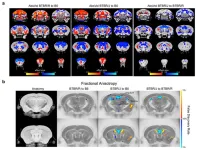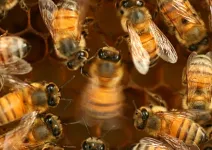(Press-News.org) Black Caribbean-British women in the UK are 58% more likely than white women to be given general anaesthesia for elective caesarean births; for Black African-British women, they are 35% more likely to have general anaesthesia
For emergency Caesarean births, Black Caribbean-British women are 10% more likely than white women to be given general anaesthesia
For vaginal births, Bangladeshi-British (by 24%), Pakistani-British (by 15%) and Black Caribbean-British (by 8%) women less likely than white women to receive an epidural
Black women are approximately 40% less likely to have an assisted vaginal birth (forceps/ventouse [suction] delivery) compared to white women but instead are more likely to have an emergency caesarean birth.
Embargo: 2301H UK time Thursday 9 March
New research published in Anaesthesia (a journal of the Association of Anaesthetists) shows that black pregnant women in the UK are much more likely than white women to be given general anaesthesia during Caesarean section births, while some black and south Asian women having vaginal births are less likely than white women to receive an epidural (a type of anaesthetic used to provide pain relief in labour).
The authors of the study include Dr James Bamber, Consultant, Department of Anaesthesia, Cambridge University Hospitals NHS Foundation Trust, Cambridge, UK, and Dr Nuala Lucas, Consultant, Department of Anaesthesia, London North West University Healthcare NHS Trust, Harrow, UK, and Marian Knight, Professor of Maternal and Child Population Health at the National Perinatal Epidemiology Unit, University of Oxford, UK. They say that the reasons for these differences are unknown, but there should be further research to see if improvements can made to reduce any inequalities in the different types of pain relief and anaesthesia that women can receive for childbirth.
With general anaesthesia a woman is unconscious during the caesarean birth of her baby and is at more risk of serious medical complications compared to being awake with a spinal or epidural anaesthetic. The quality of recovery after caesarean birth with a spinal or epidural anaesthetic is better than after general anaesthesia. Over 95% of women who have caesarean births in the UK have a spinal or epidural anaesthetic and are awake during the delivery of their baby. For women who have planned, non-emergency caesarean births, less than 2% will have general anaesthesia.
An epidural is a relatively safe intervention that can provide excellent pain relief for labour that can improve the parental birthing experience. The World Health Organization (WHO) has recommended epidural analgesia for healthy pregnant women requesting pain relief during labour, depending on a woman’s preferences. Recent research has found that the use of epidural pain relief in labour has also been associated with less risk of severe complications for the mother during labour and delivery, and that babies born to women who had epidural pain relief may have better childhood developmental outcomes.
It is known that there are differences in maternal and neonatal outcomes for women from different ethnic groups in the UK. The maternal death rate in black women is four times that of white women and there is a higher incidence of stillbirth, preterm labour and fetal growth restriction in South Asian and black women compared with white women. Minority ethnic women reported a poorer maternity care experience than white women. However, until now, there has been no published study of the relationship between ethnicity and obstetric anaesthetic care in the UK.
In this new study, using routine national maternity data for England (hospital episode statistics admitted patient care) collected between March 2011 and February 2021, involving data for 2,732,609 births, the authors investigated ethnic differences in obstetric anaesthetic care adjusting for any differences between ethnic groups for maternal age; geographical residence; deprivation; year of delivery; number of previous deliveries; and pre-existing health conditions including obesity.
This study found that Black Caribbean-British women in the UK were 58% more likely than white women to receive general anaesthesia during elective caesarean births and Black African-British women were 35% more likely. For emergency caesarean births, Black Caribbean-British women are 10% more likely than white women to have general anaesthesia.
Compared to white women who had vaginal births, Bangladeshi-British women were 24% less likely to have an epidural, whilst Pakistani-British women were 15% less likely and Black Caribbean women 8% less likely.
Other studies that have found differences in obstetric anaesthesia care between ethnic or racial groups have mostly come from the USA, where access to healthcare maybe determined by insurance or economic status. The authors say, “In contrast to other published studies of obstetric anaesthetic care by ethnicity, the care of the women in our dataset was provided within an integrated national healthcare system, where care is provided free at the point of access and where a woman’s access to obstetric care and her anaesthesia choices should not be limited by her personal financial circumstances.”
Another finding in the study was that black women were 40% less likely to have an assisted (forceps/ventouse) vaginal delivery compared to white women but instead were more likely to have an emergency caesarean birth.
The authors note the limitations of their study, which include that it is observational and therefore cannot explain the reasons for the differences found. In addition, the study analysis depended on the accuracy of the data collected by hospitals. Furthermore, there may be other unknown factors, not collected in national statistics, about how a woman’s labour and delivery was managed, that were not accounted for in the analysis and may have contributed to the differences found in the study.
The authors discuss how differences in the maternity care given to women with different ethnicity may arise from barriers to information and knowledge, as well as barriers to choosing how and where care is provided. There can also be empathy biases from healthcare professionals, for example the interpretation of the labour pain experience of women from different ethnic groups.
The authors conclude: “Ethnic disparities may reflect different cultural attitudes in different ethnic communities and arise from positive maternal preferences and choices. However, it behoves health professionals and providers to ensure any differences in anaesthesia rates are not due to inequities in the access, delivery or quality of care before they are attributed to personal or cultural preferences. To ensure that obstetric anaesthetic care is equitable, the information provided in maternity care on the choices for anaesthesia and analgesia must be easily accessible in terms of availability, language and readability, and should be culturally cognisant. There is a need to listen better to women from ethnic minorities so as to avoid health professional misconceptions and presumptions about women’s expectations and experiences of their perinatal care.”
Dr James Bamber, Consultant, Department of Anaesthesia, Cambridge University Hospitals NHS Foundation Trust, Cambridge, UK. Please e-mail to arrange interview. E) james.bamber1@nhs.net
Dr Nuala Lucas, Consultant, Department of Anaesthesia, London North West University Healthcare NHS Trust, Harrow, UK. Please e-mail to arrange interview. E) nuala.lucas@nhs.net
For Marian Knight, Professor of Maternal and Child Population Health at the National Perinatal Epidemiology Unit, University of Oxford, UK, please contact Lulu Phillips in the Communications Office T) +44 1865 617 824 E) louise.phillips@ndph.ox.ac.uk
Alternative contact: Tony Kirby of Tony Kirby PR T) +44 7834 385827 E) tony@tonykirby.com
END
UK study reveals ethnic differences in obstetric anesthesia care
Black Caribbean-British women in the UK are 58% more likely than white women to be given general anaesthesia for elective caesarean births; for Black African-British women, they are 35% more likely to have general anesthesia
2023-03-10
ELSE PRESS RELEASES FROM THIS DATE:
Emergency department visits for attempted suicides rose globally among youth during pandemic
2023-03-10
EMBARGOED UNTIL 4:30 PM MST, MARCH 9
Calgary, AB – Even though pediatric emergency department visits decreased greatly overall during the COVID-19 pandemic, a newly published study led out of the University of Calgary shows there was also a sharp increase in emergency department visits for attempted suicide and suicide ideation among children and adolescents in that same period of social isolation.
Dr. Sheri Madigan, a clinical psychologist in the Department of Psychology, is the lead author on the study, published today (March 9) in Lancet Psychiatry, which ...
Reducing trip hazards and decluttering can prevent falls among older people living at home
2023-03-10
Eliminating hazards around the home, such as clutter, stairs without railings and poor lighting, can reduce the risk of falls for older people by around a quarter, according to a new Cochrane review.
The review did not find any compelling evidence for other measures to reduce falls, such as making sure older people have the correct prescription glasses, special footwear, or education on avoiding falls.
It also found that decluttering and reducing hazards had the most benefit for older people who are at risk of falls, ...
Online ‘personal brands’ key to job success for Gen Z
2023-03-10
New research reveals how Generation Z perceive online ‘personal brands’ as a crucial tool to gain more advantage in job markets.
The study, led by the University of East Anglia in collaboration with the University of Greenwich, demonstrates the importance of authentically building online personal branding strategies and tactics to bridge the gap between Gen Z’s desired and perceived images on social media when job seeking.
Gen Z - the generation of people born between the late 1990s and early 2010s - are also in favour of a more dynamic, interactive, work-in-progress style of authentic personal brands, which may not necessarily show them as “perfect”, ...
Ozone pollution is linked with increased hospitalizations for cardiovascular disease
2023-03-10
Sophia Antipolis, 10 March 2023: The first evidence that exceeding the World Health Organization (WHO) ozone limit is associated with substantial increases in hospital admissions for heart attack, heart failure and stroke is published today in European Heart Journal, a journal of the European Society of Cardiology (ESC).1 Even ozone levels below the WHO maximum were linked with worsened health.
“During this three-year study, ozone was responsible for an increasing proportion of admissions ...
Development of a photonic dispersion solver
2023-03-10
An exponential increase in the amount of information required in society is making the development of new optoelectronic devices increasingly important. Recently, photonic crystals have emerged as an alternative to overcome the limitations of conventional photonic devices thanks to their ability to control photons freely in microscopic space to introduce the next generation of highly integrated devices. A research team at POSTECH has developed a photonic dispersion solver that may act as the foundation of studies on photonic crystals.
Professor Junsuk Rho (Department of Mechanical Engineering and Department of Chemical Engineering) at POSTECH along with a team from Gwangju Institute ...
Ancient virus genome drives autism?
2023-03-10
Although autism is a common neurodevelopmental disorder, the multiple factors behind its onset are still not fully understood. Animal models of idiopathic autism*1, especially mice, are often used to help researchers understand the complicated mechanisms behind the disorder, with BTBR/J being the most commonly used mouse model in the world.
Now, an international research collaboration including Kobe University’s Professor TAKUMI Toru and Researcher Chia-wen Lin et al. have made new discoveries regarding autism onset in mouse models.
In their detailed series of experiments and analyses of BTBR/J mice and the other subspecies BTBR/R, they revealed that endogenous ...
If you think you understand how incentives work, think again
2023-03-09
How can people be incentivized to drive more fuel-efficient cars, be more innovative at work, and get to the gym on a regular basis? Uri Gneezy, professor of economics and strategy at the Rady School of Management at UC San Diego explains this in his new book “Mixed Signals: How Incentives Really Work.”
In the book, Gneezy, a pioneering behavioral economist, reveals how we can create reward systems that minimize unintended consequences and maximize happiness, health, wealth and success. “Mixed Signals” was recently included in Adam Grant’s ...
The world’s atmospheric rivers now have an intensity ranking like hurricanes
2023-03-09
American Geophysical Union
9 March 2023
AGU Release No. 23-10
For Immediate Release
This press release and accompanying multimedia are available online at: https://news.agu.org/press-release/the-worlds-atmospheric-rivers-now-have-an-intensity-ranking-like-hurricanes/
AGU press contact:
Rebecca Dzombak, +1 (202) 777-7492, news@agu.org (UTC-5 hours)
Contact information for the researchers:
Bin Guan, University of California Los Angeles and California Institute of Technology, bin.guan@jpl.nasa.gov (UTC-8 hours)
WASHINGTON — Atmospheric rivers, which are long, narrow bands of water vapor, are becoming more intense and frequent with climate ...
Complex learned social behavior discovered in bee’s ‘waggle dance’
2023-03-09
Passing down shared knowledge from one generation to the next is a hallmark of culture and allows animals to rapidly adapt to a changing environment.
While widely evident in species ranging from human infants to naked mole rats or fledgling songbirds, early social learning has now been documented in insects.
Publishing in the journal Science, a University of California San Diego researcher and his colleagues uncovered evidence that social learning is fundamental for honey bees. Professor James Nieh of the School of Biological Sciences and his collaborators discovered that the “waggle dance,” which signals the location ...
Social signal learning enhances a honey bee’s waggle dance performance
2023-03-09
Social learning plays an important role in a honey bee’s ability to “waggle dance,” report researchers, who observed that honey bees not exposed to the dances of older, more experienced nestmates produced disordered dances full of errors. The findings demonstrate that social learning shapes this complex form of insect communication, just as it does in humans, birds, and other social vertebrate species. The waggle dance is a behavior that honey bee foragers use to communicate spatial information about the precise location of a food source to other nestmates. ...
LAST 30 PRESS RELEASES:
Signature patterns of brain activity may help predict recovery from traumatic brain injury
Dresden study uncovers new key mechanism in cancer cells
New species are now being discovered faster than ever before, study suggests
Cannabis-based products show limited short-term benefit for chronic pain, with increased risk of adverse effects
Cannabis products with more THC slightly reduce pain but cause more side effects
Clearing the brain of aging cells could aid epilepsy and reduce seizures
Brain injuries linked with potential risk of suicide, new study finds
New technique lights up where drugs go in the body, cell by cell
New study finds movement of fishing fleets can reveal shifts in marine ecosystems
Embargoed: New evidence points to potential treatment for vascular dementia
Study uncovers disrupted brain balance in alcohol dependence
Working in groups can help Republicans and Democrats agree on controversial content moderation online
Structural findings reveal how distinct GPCR ligands create different levels of activation
Anything-goes “anyons” may be at the root of surprising quantum experiments
UC review: Maximizing workplace opportunity for veterans
From generation to complex control: Metasurfaces make perfect vortex beams "within reach"
Thin-film lithium niobate-based detector: recent advances and perspectives
Exploring why some people may tend to persistently make bad choices
How cells balance their protein levels
Nirsevimab vs RSVpreF vaccine for RSV–related hospitalization in newborns
Effectiveness and impact of maternal RSV immunization and nirsevimab on medically attended RSV in US children
AI gives scientists a boost, but at the cost of too many mediocre papers
Next-generation vision model maps tree growth at sub-meter precision
Genes aren’t destiny for inherited blindness, study shows
MIT study: High-fat diets make liver cells more likely to become cancerous
Exposure to multiple fine particulate matter components and incident depression in the US Medicare population
Risk of burdensome health care spending over time in the US
Nirsevimab against hospitalizations and emergency department visits for lower respiratory tract infection in infants
New microfluidics technology enables highly uniform DNA condensate formation
A new strategy for immune tolerance
[Press-News.org] UK study reveals ethnic differences in obstetric anesthesia careBlack Caribbean-British women in the UK are 58% more likely than white women to be given general anaesthesia for elective caesarean births; for Black African-British women, they are 35% more likely to have general anesthesia




